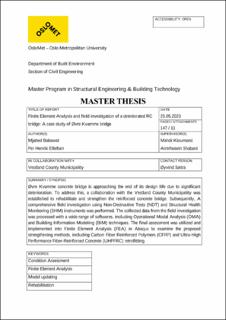| dc.description.abstract | A significant number of concrete bridges in Norway are currently approaching the end of their anticipated design life due to deterioration and poor condition. Over the years, these bridges have been subjected to various environmental factors, heavy traffic loads, and limited maintenance, leading to significant wear and structural degradation. The Øvre Kvamme bridge situated in Lærdal municipality, is an aged reinforced concrete structure that has experienced significant deterioration.
In response to this, the Vestland County Municipality has initiated a collaboration to assess the bridge and explore rehabilitation options aimed at improving its mechanical strength and durability. To effectively adress these challenges, a comprehensive field investigation was conducted, emplying various Non-Destructive Testing (NDT) and Structural Health Monitoring (SHM) instruments. The extracted results was processed with a comprehensive condition assessment of the bridge, and through a wide range of softwares with the help of Building Information Modeling (BIM). Subsequently, the findings are complemented by structural analysis using Operational Modal Analysis (OMA), Finite Element Modeling (FEM) and Nonlinear Finite Element Analysis (NFEA) to analyze and assess the behavior of Øvre Kvamme bridge with and without retrofitting.
The results from the field investigation on the bridge revealed significant deterioration mainly due to corroded reinforcement likely from carbonation. The severe detected degradation is impacting its serviceability and load-bearing capacity, necessitating urgent repair and strengthening. Adhering to standard and regulations, measures such as removing damaged concrete, addressing corrosion, and ensuring strong material bonds are crucial for rehabilitation of the bridge.
An feasable finite element model was developed to replicate the behavior of the bridge, and various configurations of two strengthening materials were tested using FEM software Abaqus. The objective was to assess their impact on the flexural behavior of the bridge and determine the most effective approach to enhance its load-bearing capacity and durability. The use of Carbon Fiber Reinforced Polmyers (CFRP) and Ultra-High Performance Fiber-Reinforced Concrete (UHPFRC) was found effective in achieving this. Specifically, the simulations demonstrated that UHPFRC performed superior under realistic traffic loads, whereas retrofitting with CFRP provided the greatest flexural resistance at a much higher loads | en_US |
